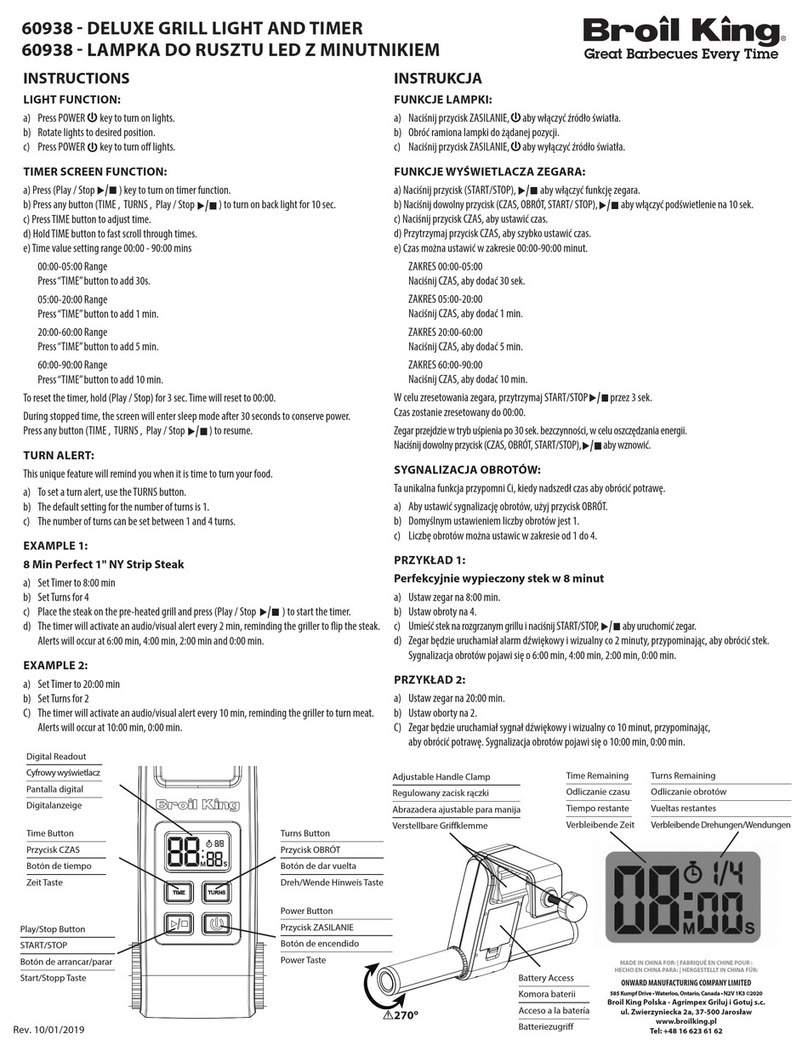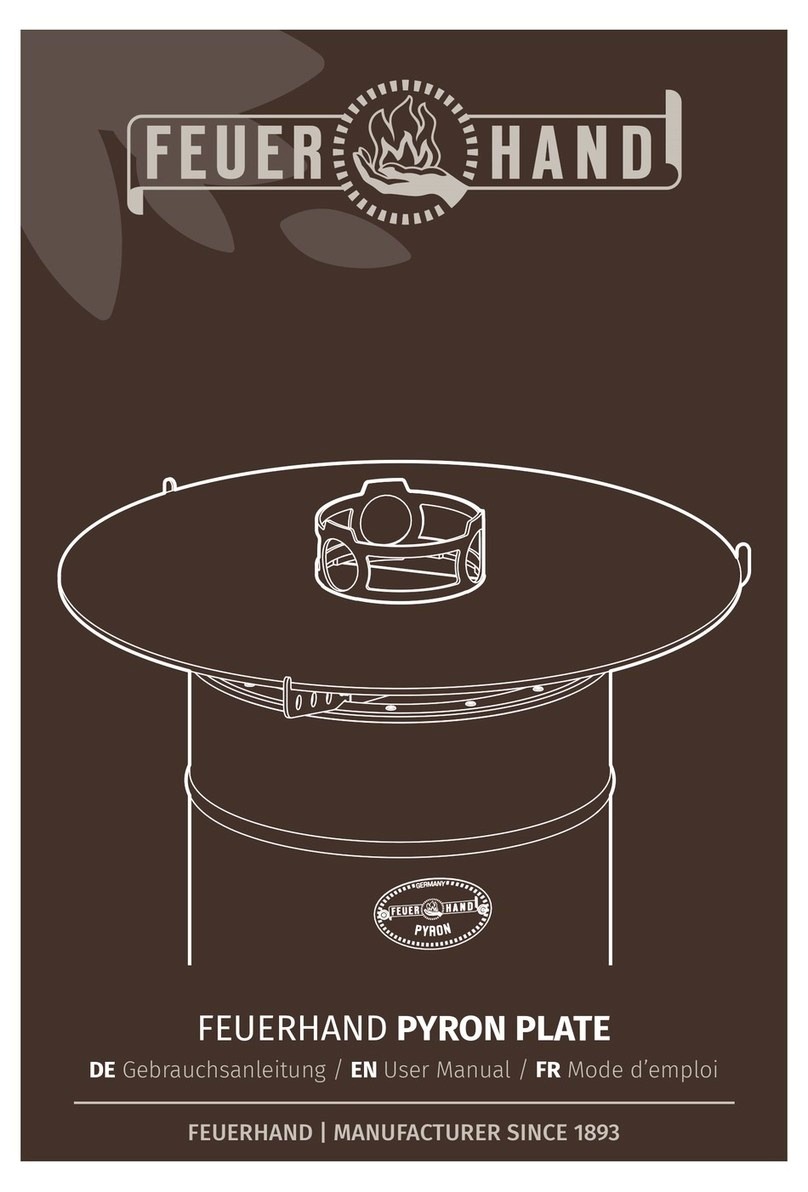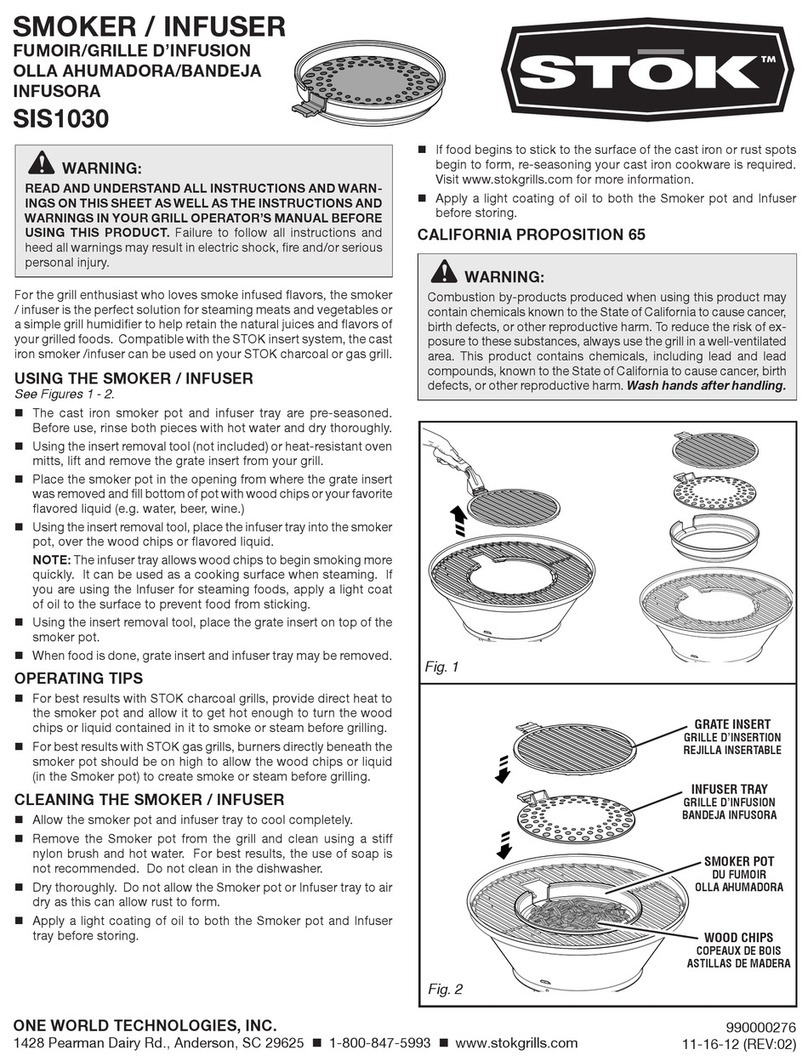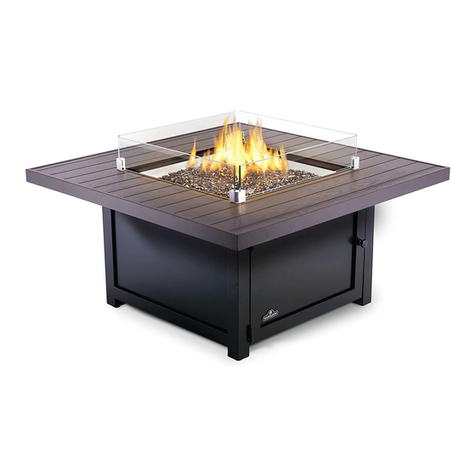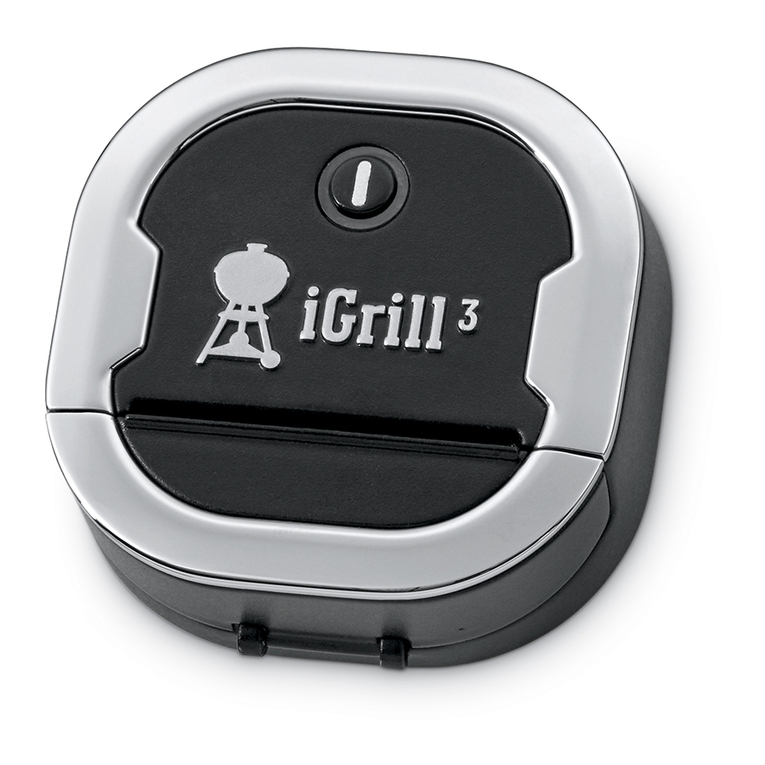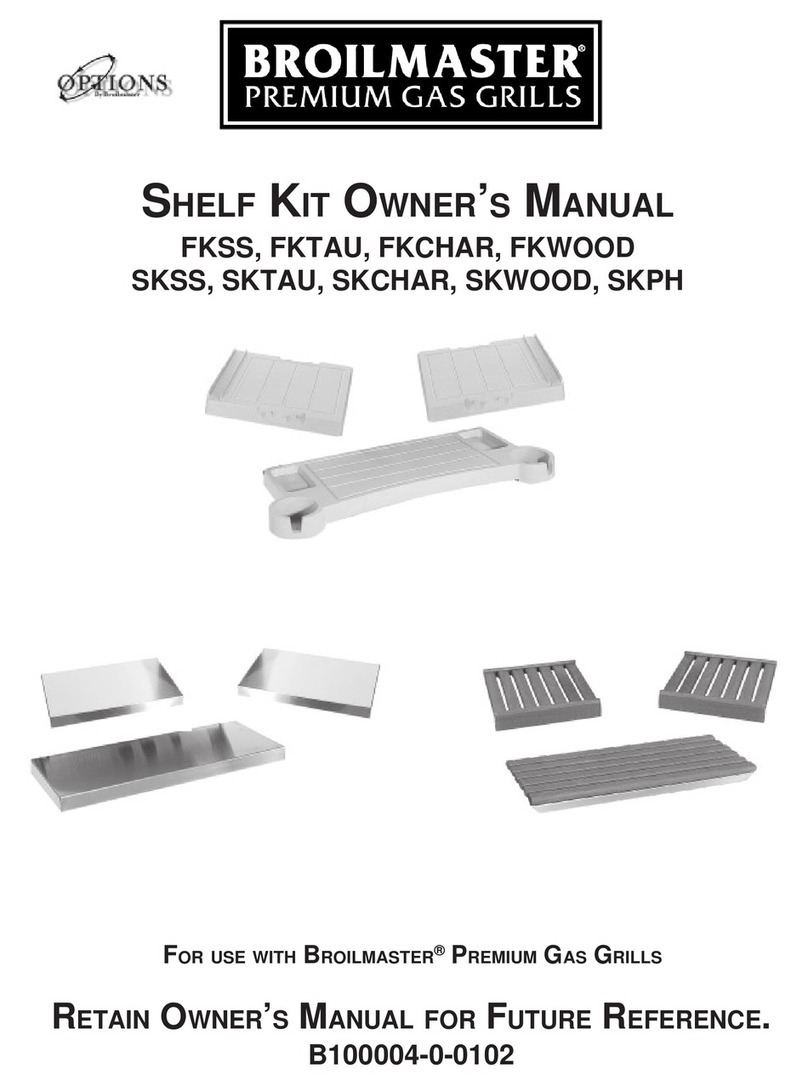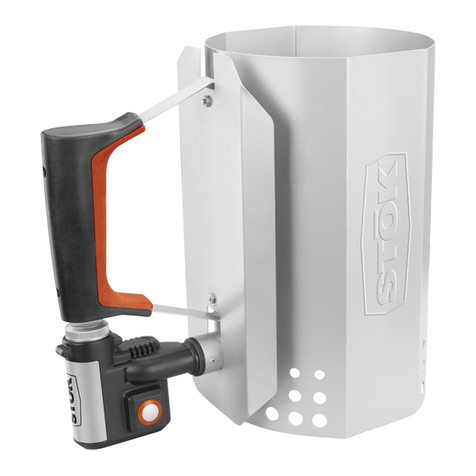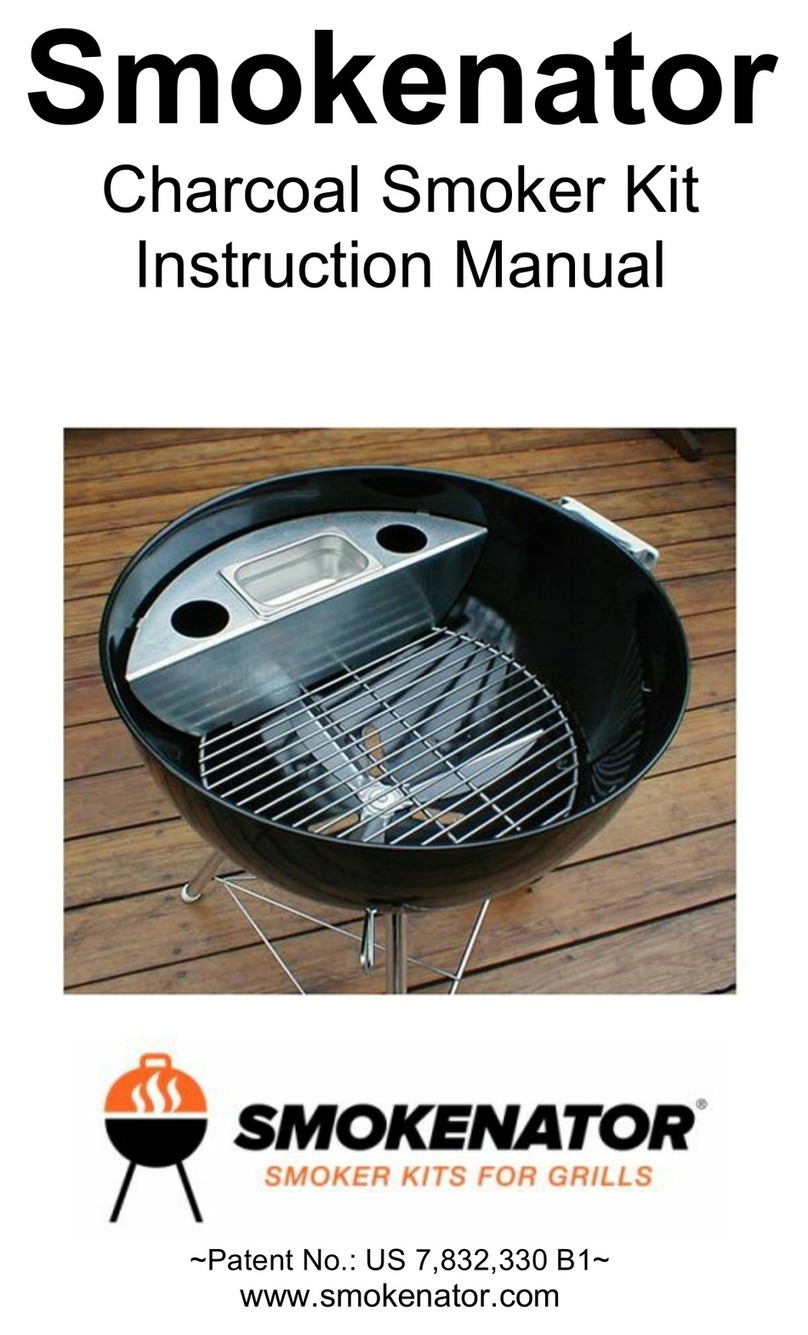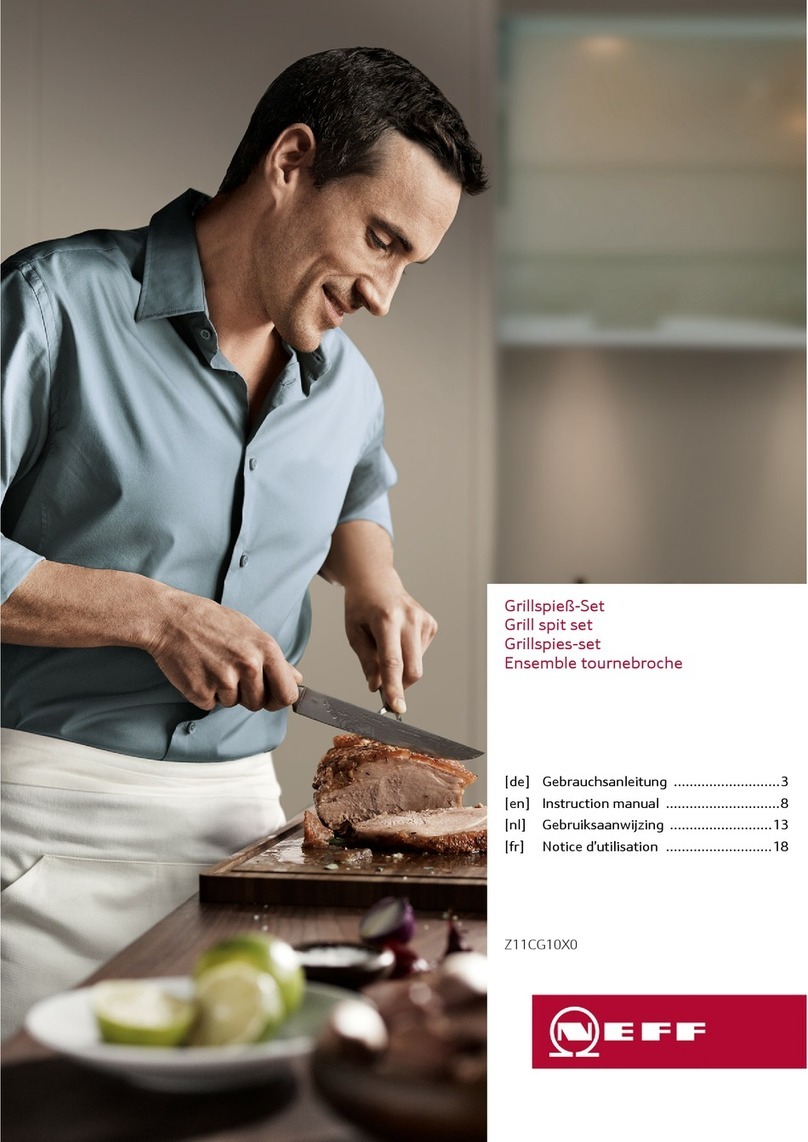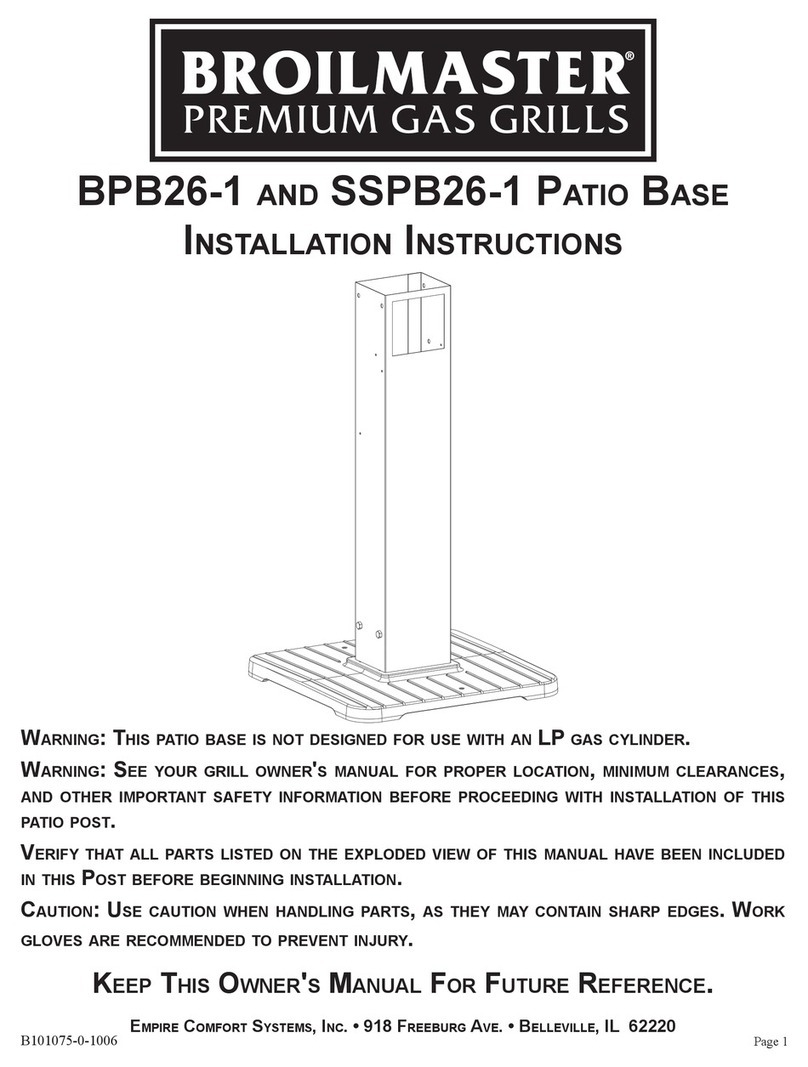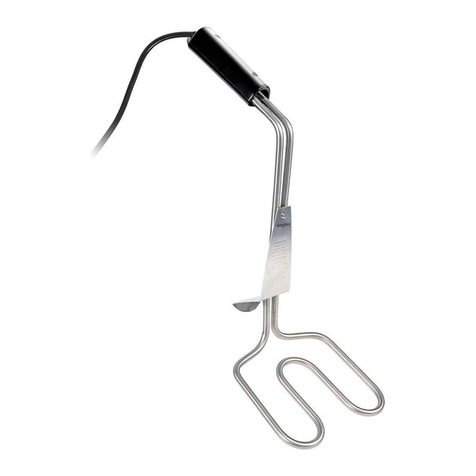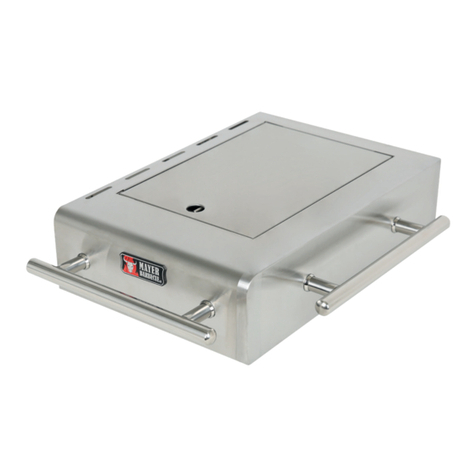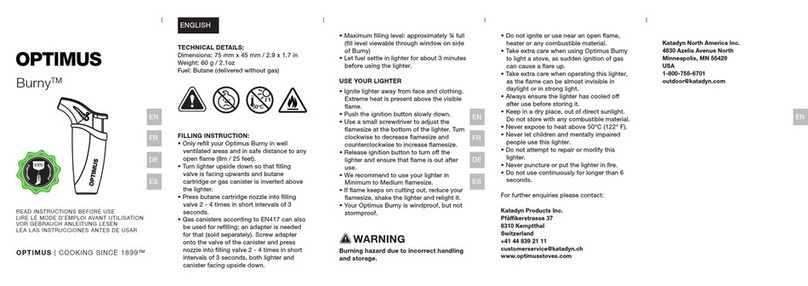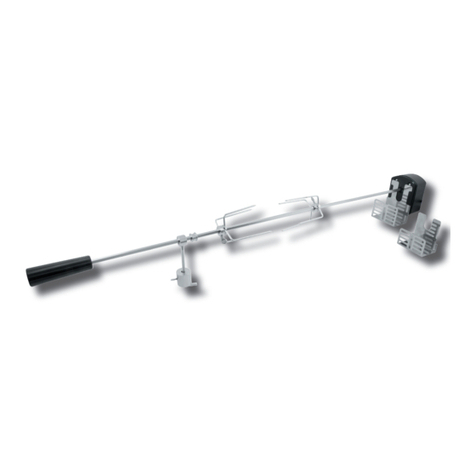Jenn-Air AG340 User manual

JENN-AIR
Use & Care Manual
WOK Accessory
Model AG340-For Gas Grill-Range Cooktops
Printed in U.S.A Cat. No.CRA340UB
© 1992Jenn-Air Company Part No. 205970A 4/92

SAFETY
PRECAUTIONS
Read before operating your WOK
All appliances--regardlessofthemanufacturer--havethepotential
through improper or careless use to create safety problems.
Therefore the following safety precautions should be observed:
1. Becertain your appliance is properly installedand grounded
by a qualified technician.
2. Never use your appliance for warming or heating the room.
3. Childrenshouldnotbe leftalone orunattended inareawhere
any appliance is in use. They should never be allowedto sit
or stand on any part of the appliance.
4. Wear properapparel.Loose-fitting or hanging garments
shouldneverbewornwhileusingtheappliance.
5. Do not repair or replaceany part of the appliance unless
specifically recommended in this manual. All other servicing
should be referred to an authorized Jenn-Air Service Con-
tractor.
6. Do not store combustible materials, gasoline or other flam-
mable vapors and liquid near cooktop.
7. Do not use water on grease fires.Smother fire or flame by
covering wok with wok lid, turn control off and ventilation
system on. Note: A dry chemical or foam type extinguisher
may also be used to put out a grease fire.

8. Use only dry potholders. Moist or damp potholders on hot
surfaces may result in burns from steam. Do not use a towel
or other bulky cloth.
9. Exercise care while stir-frying since the necessary high heat
will cause a lot of popping and steaming when food is added
to the wok.
10. CAUTION: Overheating any oil may cause a fire. If oil
smokes, reduce heat.
11. Remember, the outside of your wok will be HOT, too! Don't
wipe it or otherwise touch it with your unprotected hand while
it is hot.
12.Be extremely cautious if you must move the wok while it
contains hot liquid.
13. CAUTION: To avoid risk offire and injury, do not use for deep
fat frying.
NOTE: For additional safety precautions, please refer to the gas
grill-range or grill-range cooktop use and care manual.

About the
Jenn-Air WOK
The Jenn-Air wok combinesthe benefitsof a centuries old cooking vesselwith
moderndaytechnology.
Thewordwokmeans"cookingvessel".OriginallycreatedbytheChinesetosave
onfuel (itsunique shapeheatsfastand less energyis neededtomaintain a high
temperature), the wok haslongserved asa multi-purpose cooking utensil.The
wok canbe usedinstead ofmanyother pansinyourkitchen,suchasasaucepan
or sautepan. Thewok canalso be usedfor preparingfoods inways other than
just stir-frying for which it is noted. It can be used for poaching, steaming,
braising,stewing,simmering,parboiling, even popping corn.
The Jenn-Air wok was designed with ease of cleaning, fast heating and
versatility in mind. By removingthesurface burner grate, thewok accessory is
easily and quickly assembled for use.The wok cradle holdsthe wok to keep it
from rolling or tipping when in use.
The wok ismadefrom cold rolJedcarbon steelwhich is best for providing even,
steady,and intenseheat.Theconstant even heatmakespossiblethe veryshort
cookingtimes so important inOrientalcooking. Inthe wok, boththeflaring sides
and the rounded bottom heat upso the entiresurface can be used for cooking.
Thewok iscoveredwith ahard non-stickfinish. Thefinisheliminates theamount
ofcare requiredofanunfinishedcarbonsteelwok,suchas seasoning.Thenon-
stickfinishiseasytocleanandwill not rust. Foodswill heatveryquicklyfrom the
first day you cook in the wok, and it is not necessary to age the wok. Unlike
conventional woks, the wok is cleaned with hot, soapy water.
Thewooden handlesofthe wokeliminate theneedfor using pothoJdersaswhen
grasping a hot metal wok handle.

Installing the WOK
1. Beforeinstalling the wok cradle, becer-
tain the control knob is onthe Off posi-
tionandthe surface burnergrate iscool.
2. Remove the surface burner gratefrom
the cooktop. Leave the aeration tray in
thecooktop.
3. Place the wok cradle on the aeration
tray.
4. Placewok on the wok cradle.
5. Usethe control knob tocontrol the heat
to the wok. The following temperature
settings are suggested for the various
cooking methods. The actual control
setting that provides the best results
may be different from the suggested
settings. Various factors, such as gas
.._ /_...... pressure, food load and temperature,
will affect the control setting.
/_ • Stir-frying: Hi.
• Steaming: Hi to bring water to boil;
reduce to setting Meal to maintain
steam.
_, • Braising: Hi to brown meat; reduce
to settingLo for longterm simmering
and stewing.
Note: Use the wok onthe right side of the
cooktop for the best results.

Caring for the WOK
The nonstickfinish,whichdoes not needseasoning,eliminatesthe specialcare
necessarywith traditional woks. There are afew tips that should befollowed in
order to preserve the beauty of the finish.
• Before using the wok the first time, wash the wok in hot, soapy water.
Rinse and dry thoroughly.
• Donotseasonthe wok accordingtoprocedures givenfor unfinishedsteel
woks. Doingso may reducethe wok's cleanability and non-stick charac-
teristics.
• To clean thewok after use,wash with hot, soapy water orlet soak until
food particles can be easily removed with a sponge or cloth. A plastic
scrubber, BonAmi orother nonabrasive cleaners can be usedfor difficult
to remove residue. Be sure wok isclean; tiny food particles may adhere
to the finish.
• Evaporationofwaterduring steamingleaves mineraldepositinwokwhich
can beremoved with hot soapy waterand plasticscrubber.If the wok's
finish isdiscolored by mineral deposits,theappearance can be restored
by applying a thin coating ofvegetable oil to the wok.
• Do not use abrasive cleaners or scrubbers not recommendedfor useon
nonstick finishes, such as Scotch Brite, since these may damage the
finish.
• Forbuilt-upresidueortackysurface, scrubverylightly withsoapyS.O.S.
pad.Thiswill not onlyremovethe residue,but mayalsoremoveor damage
the finish.
• Do not soak wood handles in water.
•Rinse and dry thewok thoroughly.
• Thewok craddlecan beremovedforstorage onceit hascooled.To clean,
wash with hot soapy water. Rinse and dry thoroughly.
• To clean the lid,wash in hot, soapy water. Dry thoroughly. Do not allow
the wooden knob of the lid to soak in water.
• Do not wash the lid or the wok in dishwasher since drying heat can ruin
the wood handles and knob and adversely affect the wok finish.
• To preserve the interior wok finish, use only the bamboo rice paddles
packaged with the wok or other non-metallic cooking utensils when stir-
frying. Do not use metallic spatulas,etc.,for they will chip,scratch and
eventually removethe wok finish. Although this will not interfere with the
performance ofthe wok, it will affect its appearance. The wok also may
rustwherethe finishisremoved exposingthe bare steel. Ifrustingoccurs,
oil lightly with vegetable oil.
• When storingthe wok, be certain all parts are completely dry.

Effciency of the WOK
Duetothe design ofthe Jenn-Air wok andwok cradle,the wok heats veryfast,
more so than with other utensils used. For this reason, never leave the wok
unattended while using it (the only possible exception is when food is being
steamedandwaterissimmering,butbesuretoperiodicallycheckthewater level
in the wok).
Once oilis added to the wok for stir-frying or browning, do not heat the wok for
more thantwo minutesbefore adding food to the wok.Overheating anyoil can
cause a fire. If the oil begins to smoke, immediately reduce the heat control
setting.
In the event a fire should occur, smother the flames with the wok lid, turn the
heating control off, then turnthe ventilation system on. Let the wok cool down
before removingthe cover.
CAUTION: DO NOT HEAT AN EMPTY WOK. If you do,the finish can be
permanently damaged. Deterioration of finish begins after the empty wok has
beenheatedon Hiafter abouttwo minutes. Finishdeteriorationwill notaffectthe
wok's performance, just its appearance.
Using the WOK
Thewok can be usedfor many different cooking methods,these being limited
only by your imagination.
Basicsuggestionsand tipsfor stir-frying,steaming andbraising (orstewing) are
given inthis manual.
The recipes provided are just to whet your appetite.There are numerous
excellent cookbooks on wok and Oriental cooking which can add to your
enjoyment of this accessory.
7

Stir-Frying
This methodofcooking was developed bythe Chinese as apractical solutionto
the scarcity of fuel. Stir-frying is quick cooking, stirring and tossing of foods in
a small amount of oil over very high heat. Foods are not fried but are actually
flash-cooked or toss-cooked. The quick searing maintains the crispness and
texture ofvegetables and sears inthejuices of meat.The useof little oilisgood
for dieters. Although the cooking method is uniquely Chinese, it is easily
adaptableto many different foods.
To Stir-Fry:
1. Prepare all recipe ingredients first. Line up all the ingredients on the
counter in the order theyare to beadded to thewok beforecommencing
tocook. Usually meatiscookedfirst.Vegetablesarecooked nextwith the
most dense being cooked first.
2.Place clean, dry wok on wok cradle.Ringthe wok with a necklace of oil
about halfway downthe wok. About 1to 2tablespoons of oilare needed
for a pound of cut-up vegetables or meat.Turn control knob to Hi. Heat
the wok for about 2 minutes. CAUTION: Seta minute timer. Do notheat
the wok for more than two minutes.
3. Theoilshouldbeheateduntilitishotenoughtoripplewhenthewokistilted
from side to side. The oil should be hot, but not sizzling or smoking.
CAUTION:Overheating any oil may cause a fire. If oil smokes, reduce
heat controlsetting. Do not leavewok unattended while using.
4.Ifdesired,addahintofflavortooil byaddingthinslicesofseasoningssuch
asfresh garlicor gingerroot. Usingthebambooricepaddles, stirand toss
until the seasoning is browned. Remove seasoning before stir-frying if
desired.
5.Add meat,ifused. Ifmorethanone poundisbeingcooked, addinbatches.
Do not cook more than one pound of meat or shellfish at a time or itwill
stew initsownjuices. Stirandtoss themeat untilall pieces havecome in
contact with the hot wok and arelightly brownedand almost done.
Removecooked meat from wok and set aside; add more oil if needed to
cook additional batches.
8

6. Add more oil if needed. Whenthe oil is hot, add the vegetables. If more
than one typeofvegetable isbeing cooked,start with those that takethe
longest to cook. With the rice paddles, stir-fry vegetables, coating them
with oil. For vegetables that require more cooking (dense fibrous veg-
etables suchas carrots, broccoli or asparagus) add a littlewater to wok,
cover, andsteam untiltender. Removecooked vegetables andadd other
vegetables as recipestates or in accordance to their cooking time. Stir-
fry after each addition untilall vegetables aretender-crisp.
7. Returncookedmeat and vegetables towok. Add sauce, ifused. Stirand
cook food until liquid boils and thickens. Remove from wok and serve.
Tips:
• Thekeyto stir-fryingishaving everything readybefore cooking begins.
Cooking time is so short there is little time to look for or prepare
ingredients.
•Readrecipe instructions carefully before beginning.
• All ingredients should be as uniform in size and shape as possible for
quick, even cooking.
• Foodsthat are cut in thin, small pieceswill cook more quickly and will
retain their natural texture, color and flavor.
• Cut fibrous vegetables such as celery and broccoli and meats such as
flank steak into diagonal slices. This helpstenderize them as well as
exposethe maximum food surface to the heated wok during cooking.
• Cut less fibrous vegetables into wafer thin slices or dice.
• To steam stir-fried vegetables, stir-fry 30 seconds then add 1 table-
spoon water; cover wok with lid; steam for 60 seconds after steam
comes from around lid.
• Meatsfor stir-frying should be ground or cut in thin strips.
• Meatwill slice more easily if partially frozen. To partiallyfreeze a one-
inch sliceof meat, place in the freezer for 45 to 60 minutes.

• Peanut oil is the best for stir-frying since it can be heated to a high
temperature without smoking. Its bland taste does not overpower the
flavor ofthe food.
• Do not substitute solid shortening, butter or margarine for oil.
• Ifitisnecessarytoaddmore oiltothewok (ifmeatstickstothe panwhile
cookingit)letoilflowdownthe sideofthe woksothat freshoiliswarmed
by the time it hits the meat.
• Aplasticcondimentbottlewith aspout makesiteasytoringthe wokwith
oil.
• Use the two bamboo rice paddles (a right and left-hand version)
included with the wok accessory, together for ease in tossing and
stirringfoods. Liftfoodfrom thesurface ofthewok and drop backinwith
a tossing movement.
• If food is added in stages andadditional oil isadded, besure oilis hot
before addingthe next ingredient.
• Stir and toss the food rapidly and constantly and itwill be practically
impossibleto burnthe food.All stir-fryingshould bedoneatthe highest
heat possible.There should be loud cracking, hissing and popping as
food is added.Exercisecarewhen addingfoods, particularlyfrozen stir-
fryvegetables.
• Ifa sauce isadded to the food just before serving to thicken and flavor
thefood, pour liquid downthe sideofthe wok, notdirectly intothefood.
This way, the sauce is hot by the time it reaches the food.Another
methodistopush thefood awayfromthe center ofthe wok.Add sauce,
letbubbleslightly beforestirringinfood.Warmingthe liquidbeforeother
foods are added does not slow down or stop the cooking process.
• Allthe seasoning of stir-fry dishes is done in the kitchen by the cook.
• Undercook everything. Since the wok is very hot,the degree of
doneness of ingredients can be deceptive.
® Serve the finished dish immediately.
10

Steaming
Thewok's uniqueability to retainhigh heat makes ituseful as asteamer. Foods
do notdry out when steamed and they retain their color, flavor, and arejuicy.
Flavors of food mingle more completely, For diet conscious cooks, little fat, if
any, is used and vitamin and mineral loss is minimal. A wide variety of foods
including seafood, poultry, vegetables, desserts, and breads can besteamed.
Evenleftoverscan bereheated.Foodswill cook insteamasfastasinsimmering
water and with less flavor loss.
To Steam:
1. Add from 2 to 2 1/2 cups of hot water to wok.
2.Place steamer rack over water. Rack should be positioned so that cut
edgeofspokesface up;thiseliminatesthe possibilityofspokesscratching
finish. Rack should not touch water.
3. Cover wok, turn heat control to Hi and bringwater to a boil (about 4 to 5
minutes).
4. Once waterisboiling,carefully liftlid(openawayfromyoutopreventburst
of steam inface), add food to wok. Foods can beplaced directly onthe
metalsteamer rack or in a shallow platewhich is then set on the rack. If
a utensilorplateisused,besureitdoes notcoverthe entiresteamingrack;
allow room for steam to circulate. A clear utensil has the advantage of
allowing you to watch water level in wok.
5. Cover wok. Reduce heatsetting to Mealto maintainsteam. Keep atleast
an inch or more of water boiling under rack.
6.Steam for time in recipeor the same amount oftime for foods simmered
in water.
7.Forlongterm steaming,checkthe water leveloccasionallytobesurewok
doesn't dry out. Add boiling water as needed.IMPORTANT: Do not let
wok continue to heat without water; this can ruin the finish.
11

Tips:
•Toflavorfood, sprinkle withherbs
and spices or surround food with
slices of onion or lemon. _"
• Whenusingthemetallid,drops of
water may form on it. Lay a piece
of wax paper or foil loosely over
certainfoods,suchasvegetables,
custards, desserts, or breads, to
preventcondensationfrom falling
onto foods.
• Use the lid that comes with the wok for steaming. Bamboo baskets that
stack are available at many cooking specialty shops and department
stores. These can be used when different layers of foods are being
steamedatonetime.Ifseveralbasketsareused,usethe bamboolidsince
itminimizes condensation.Thewok lidcanbe used, but besureto place
waxed paper or foil over food in top basketthat is being steamed.
• While food issteaming, donot liftthe lid oftensincethis slows orstopsthe
cooking process when steam is allowed to escape.
• At end of the steaming time,turn the controloff. Carefully remove the lid
away from you. Remember, steam causes severe burns.
• Carefully removefoodfrom steaming rackwith twolargespatulas,mittor
potholders. When removinga hot dish from the steamer, exercise care.
Do not allow hot pads to soak up water. Three-pronged steamer dish
retrievers are useful for removing hotdishes.
12
Table of contents
